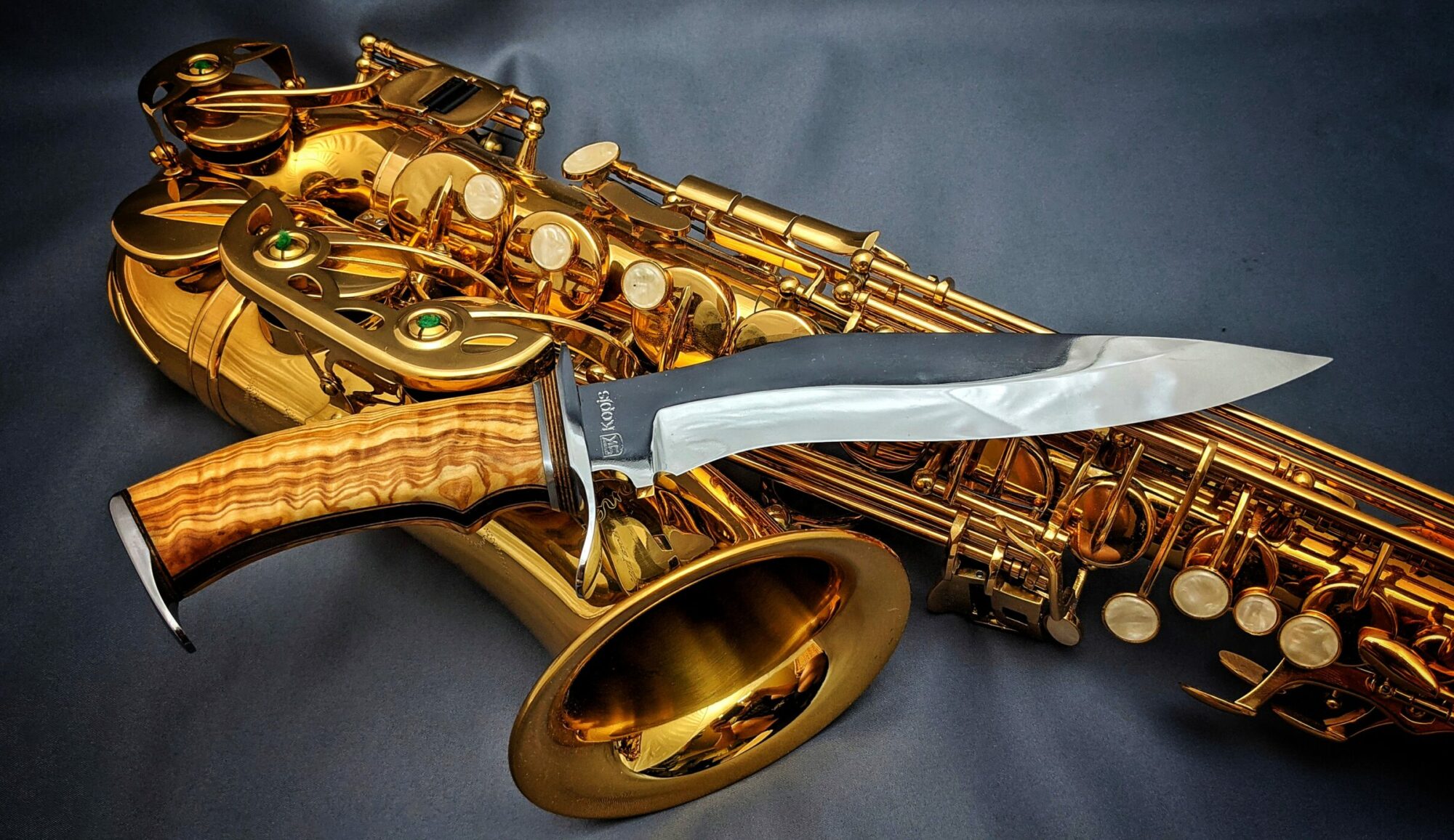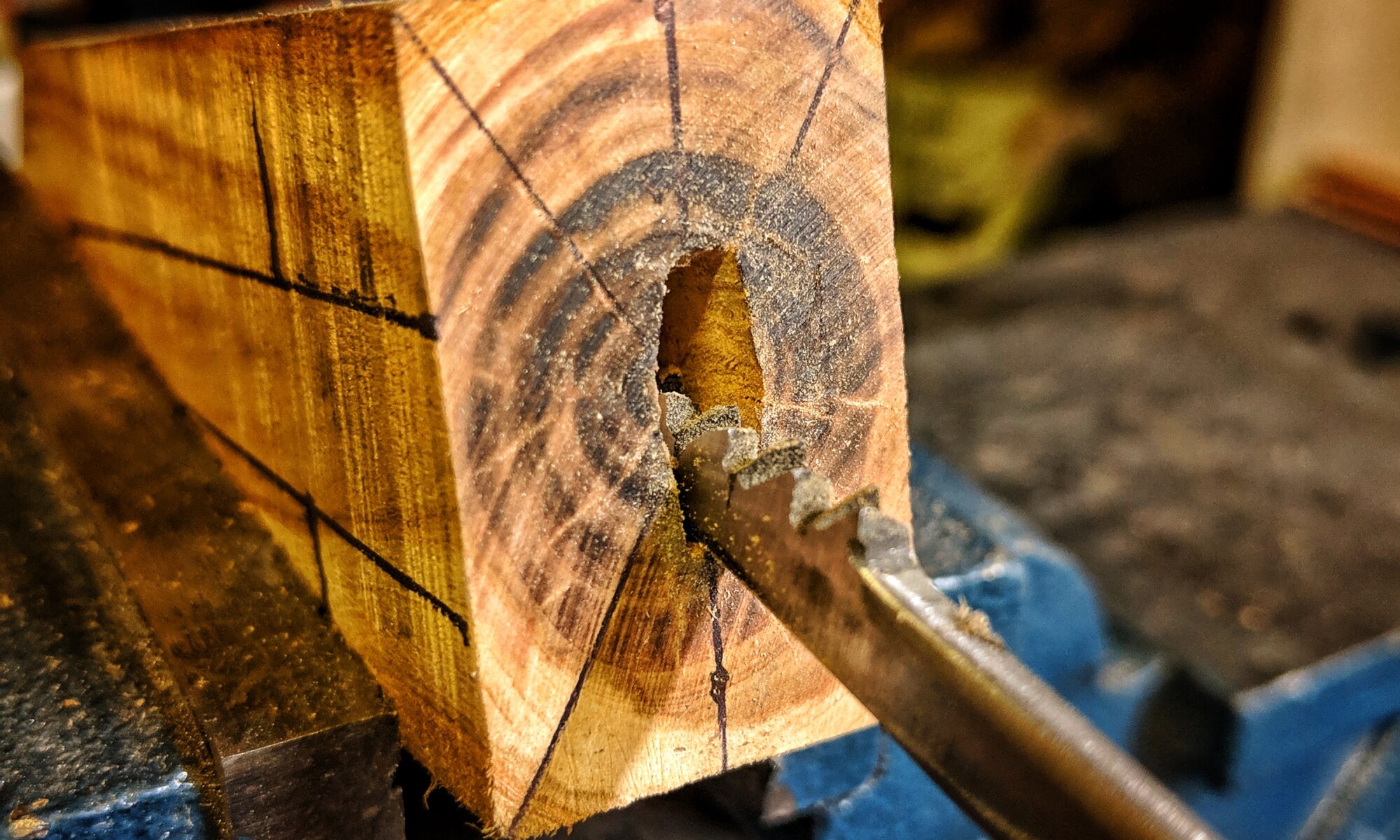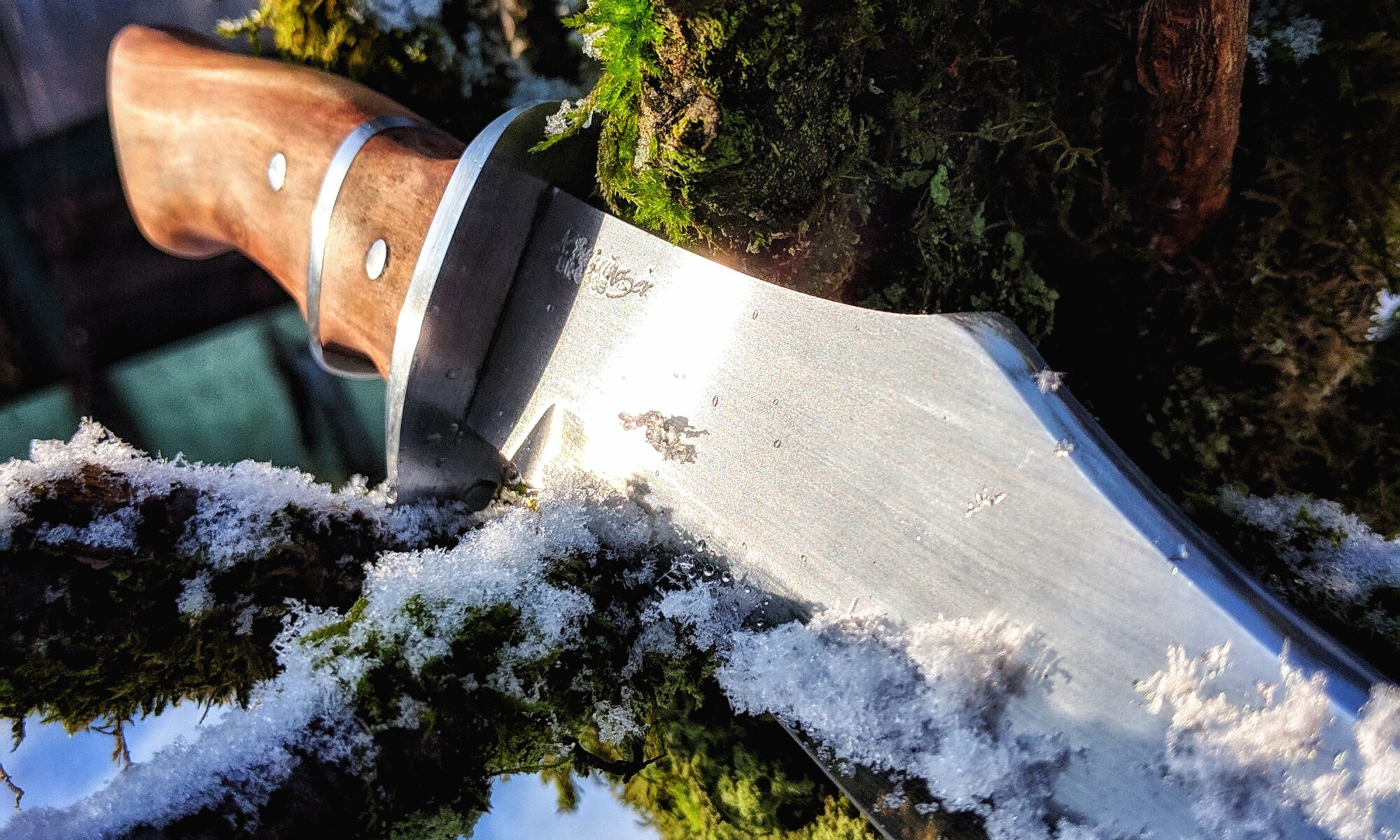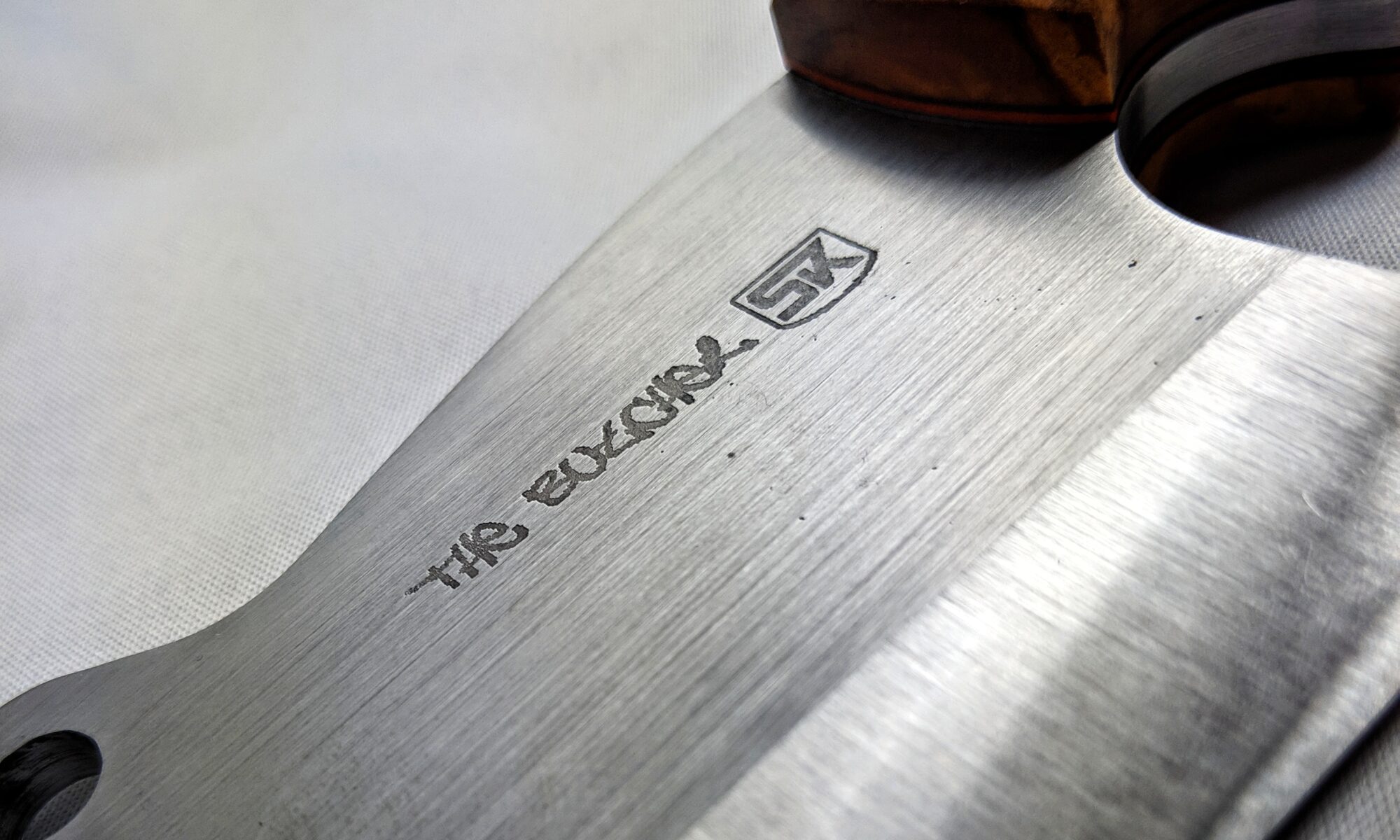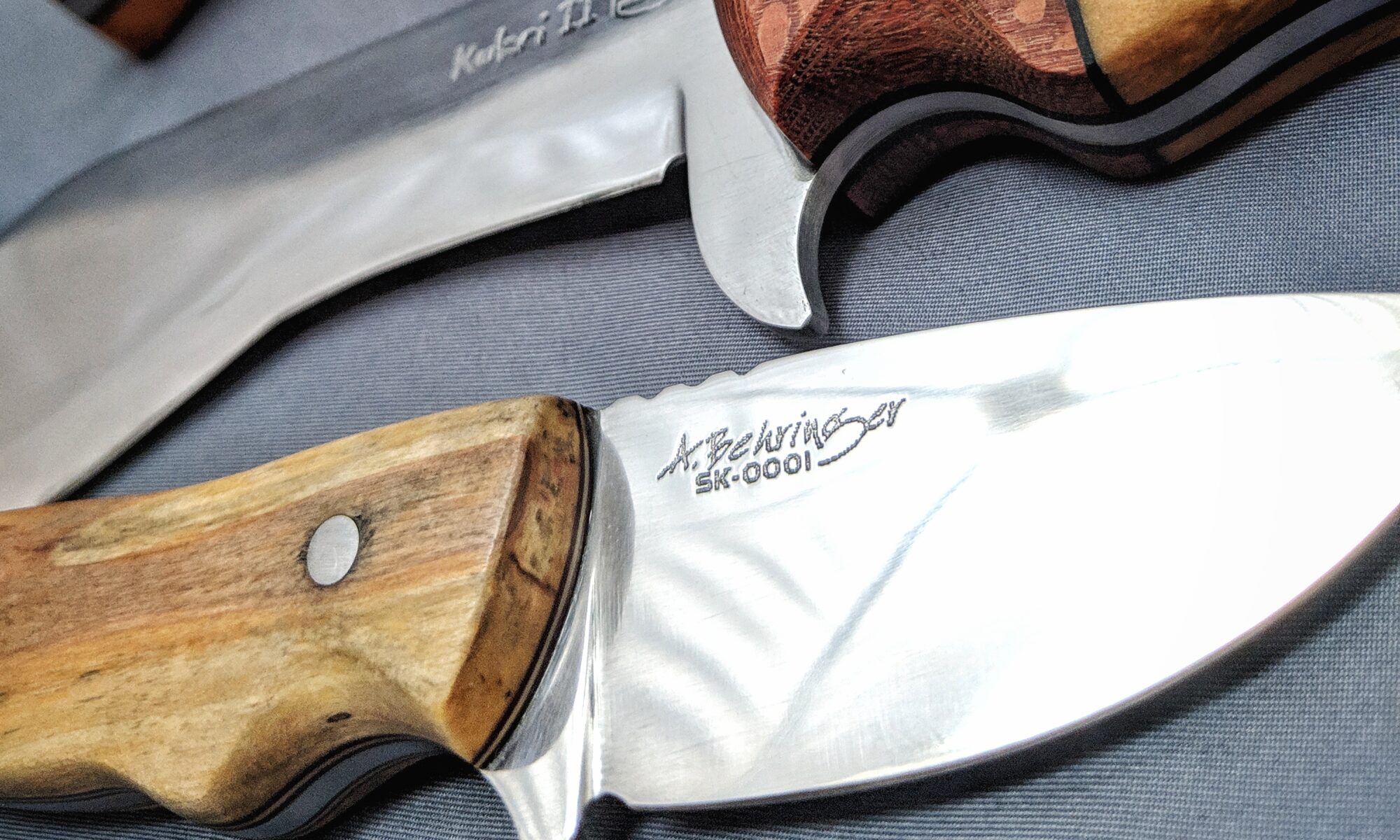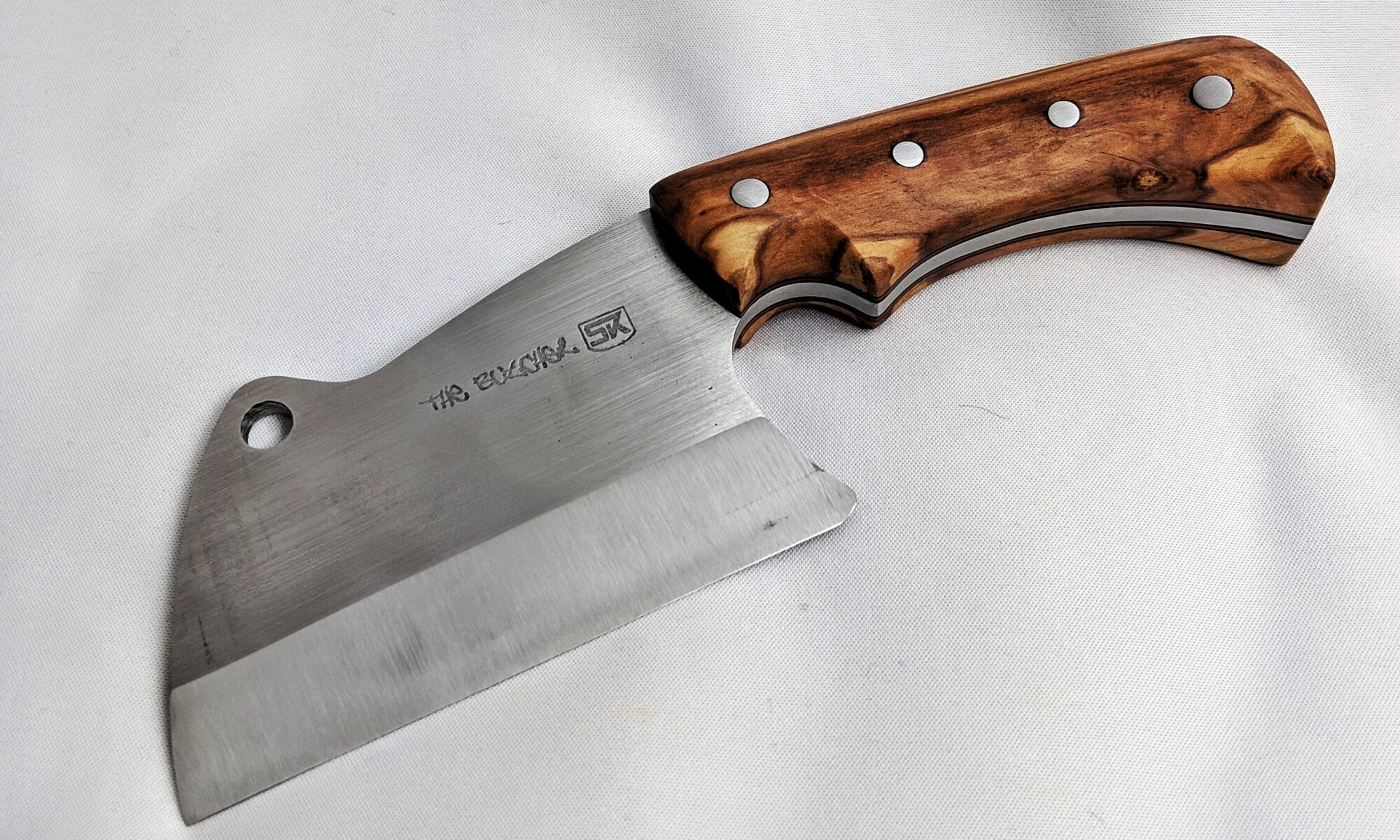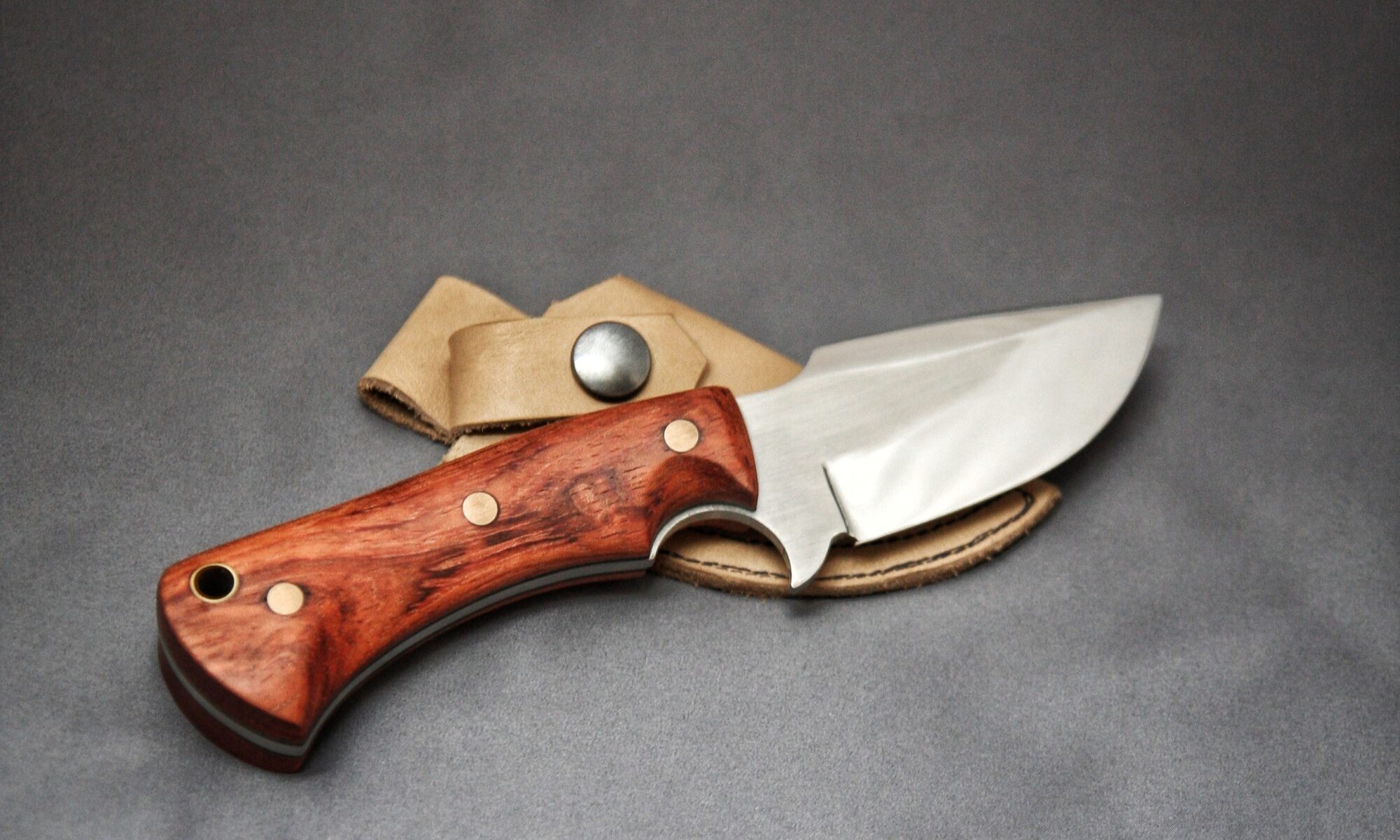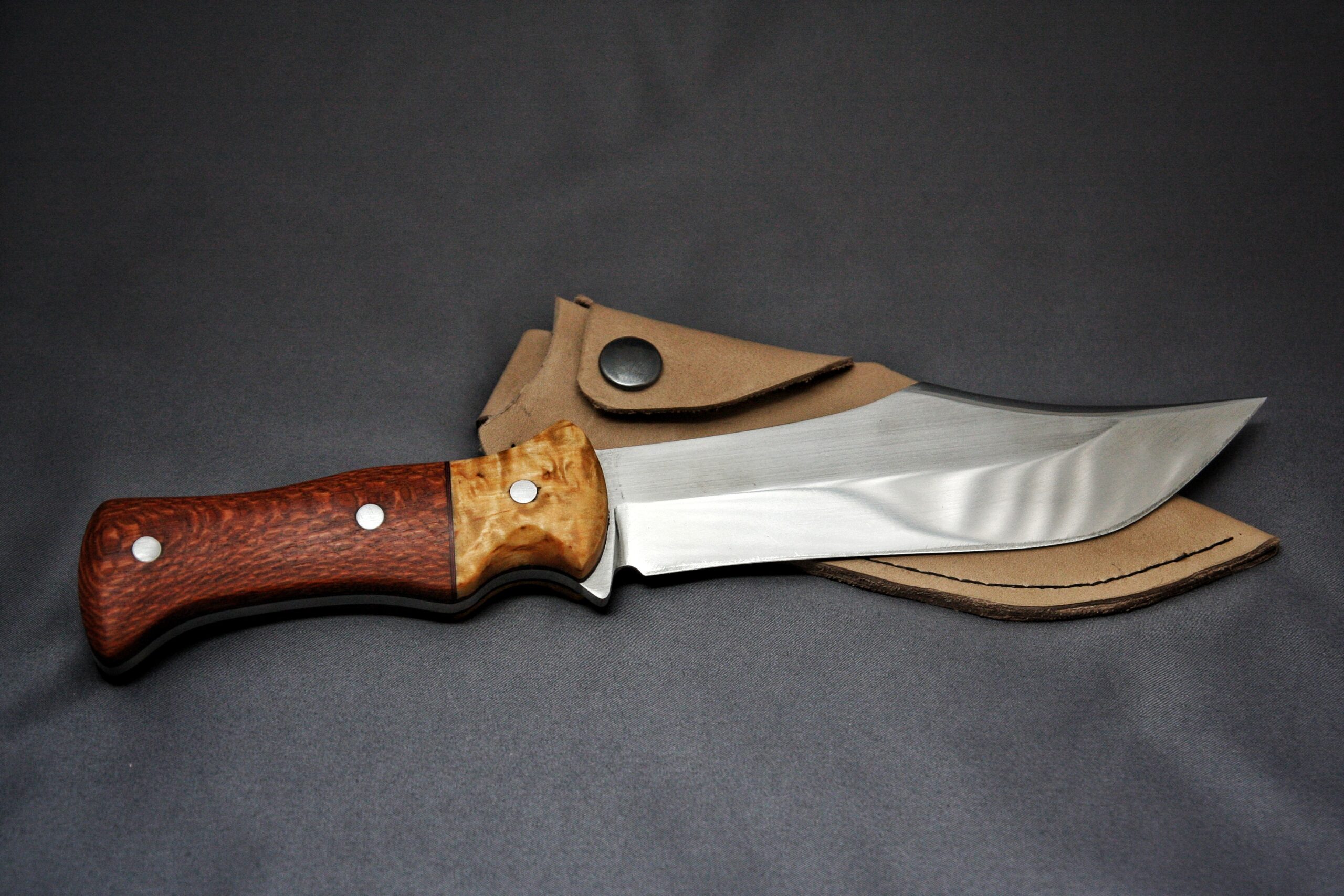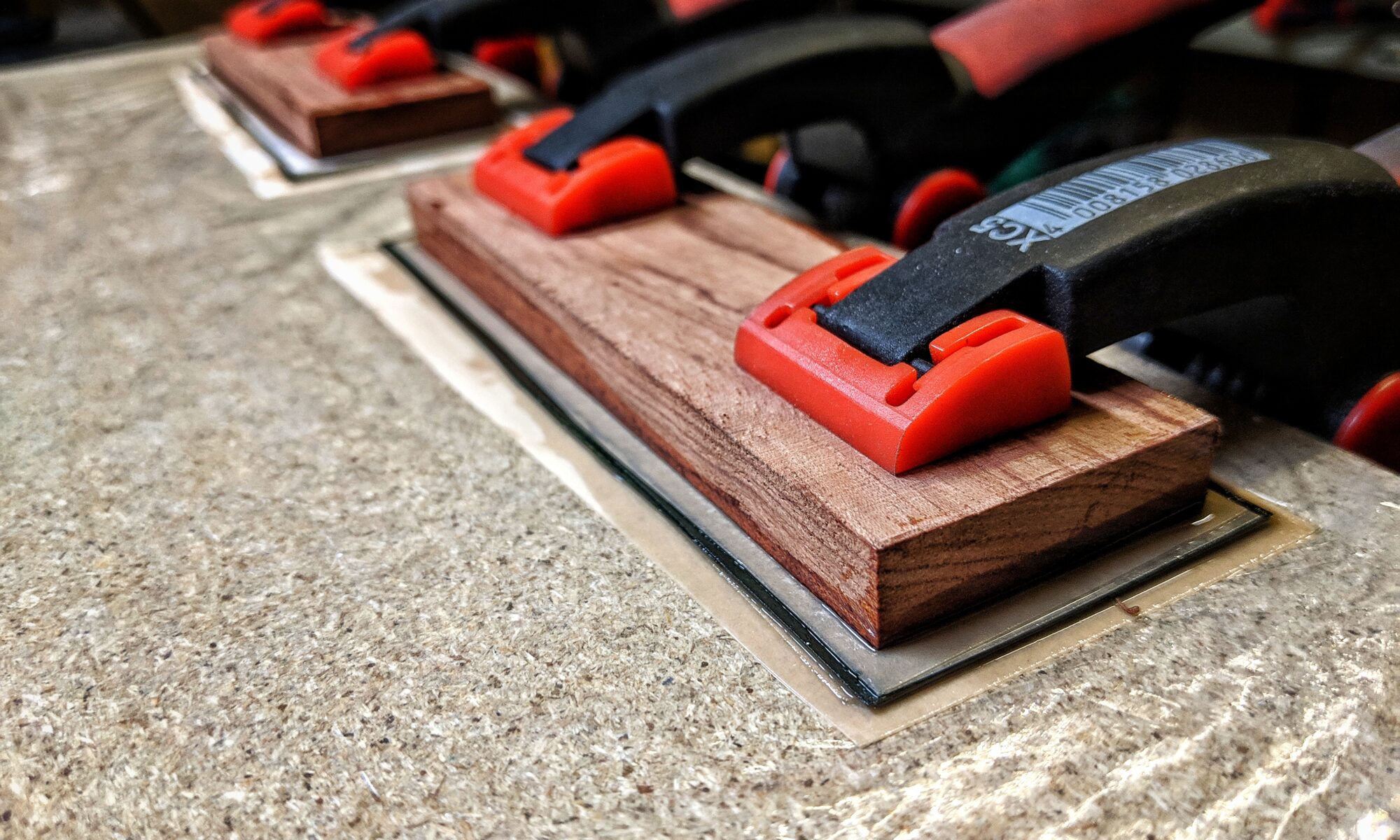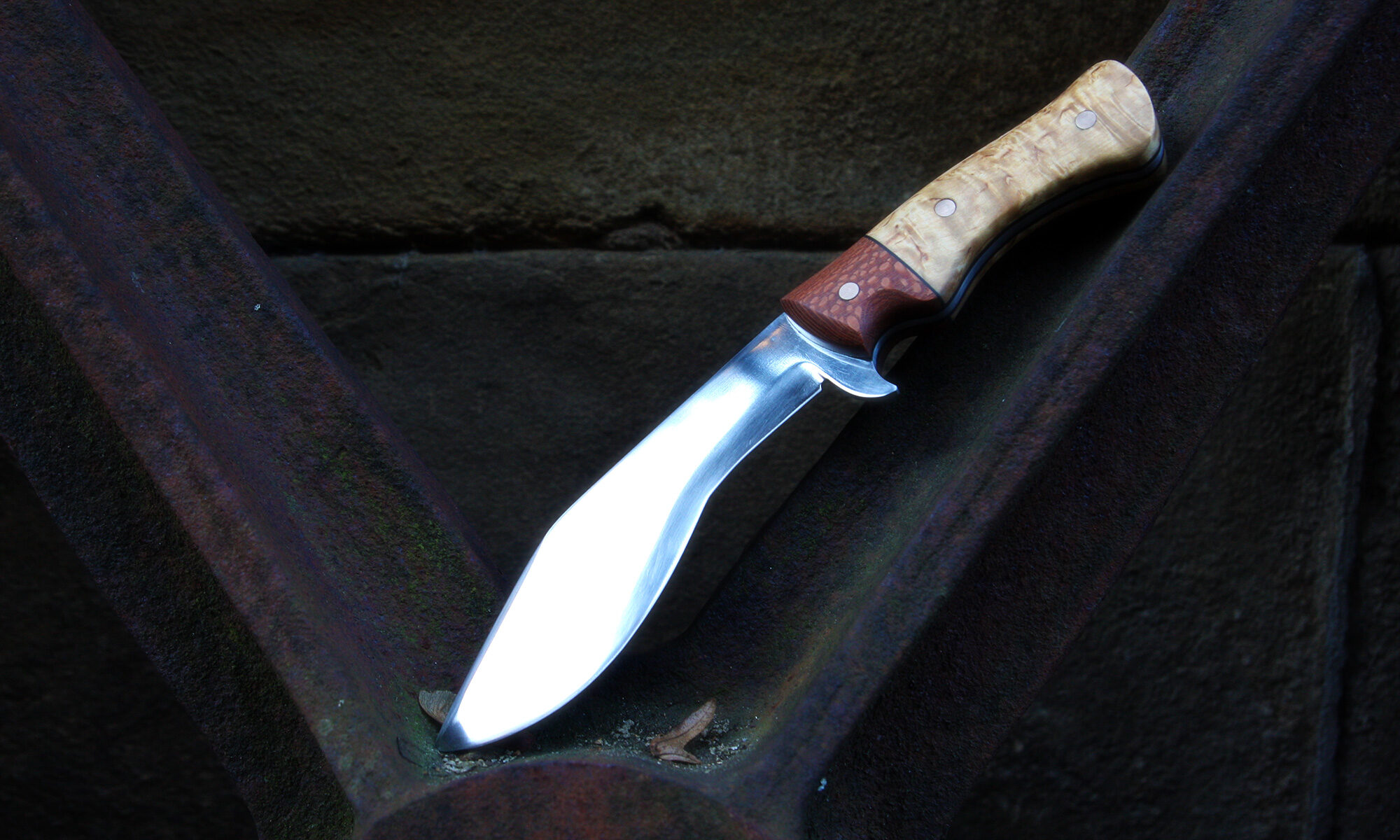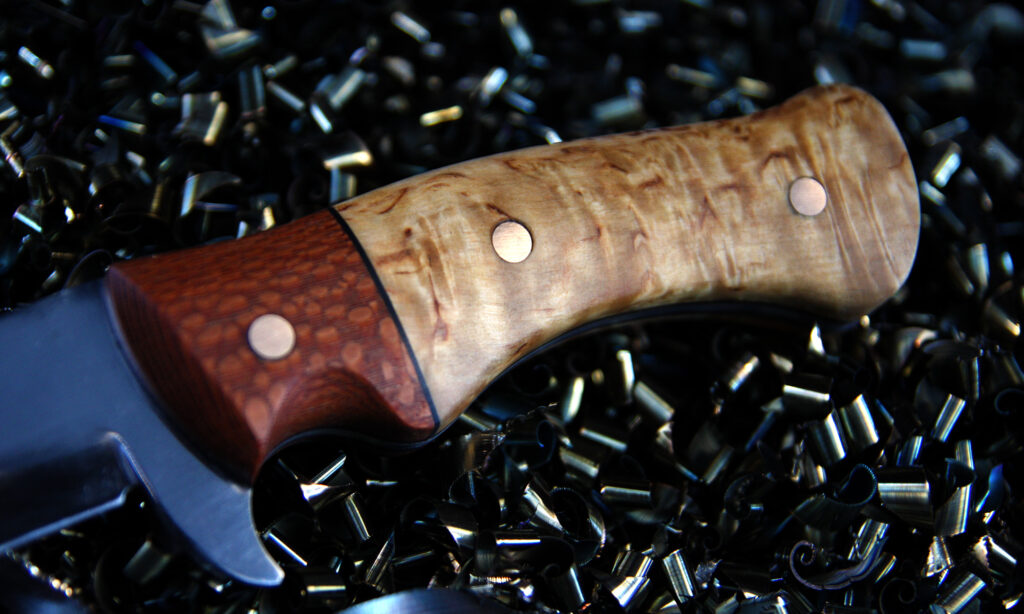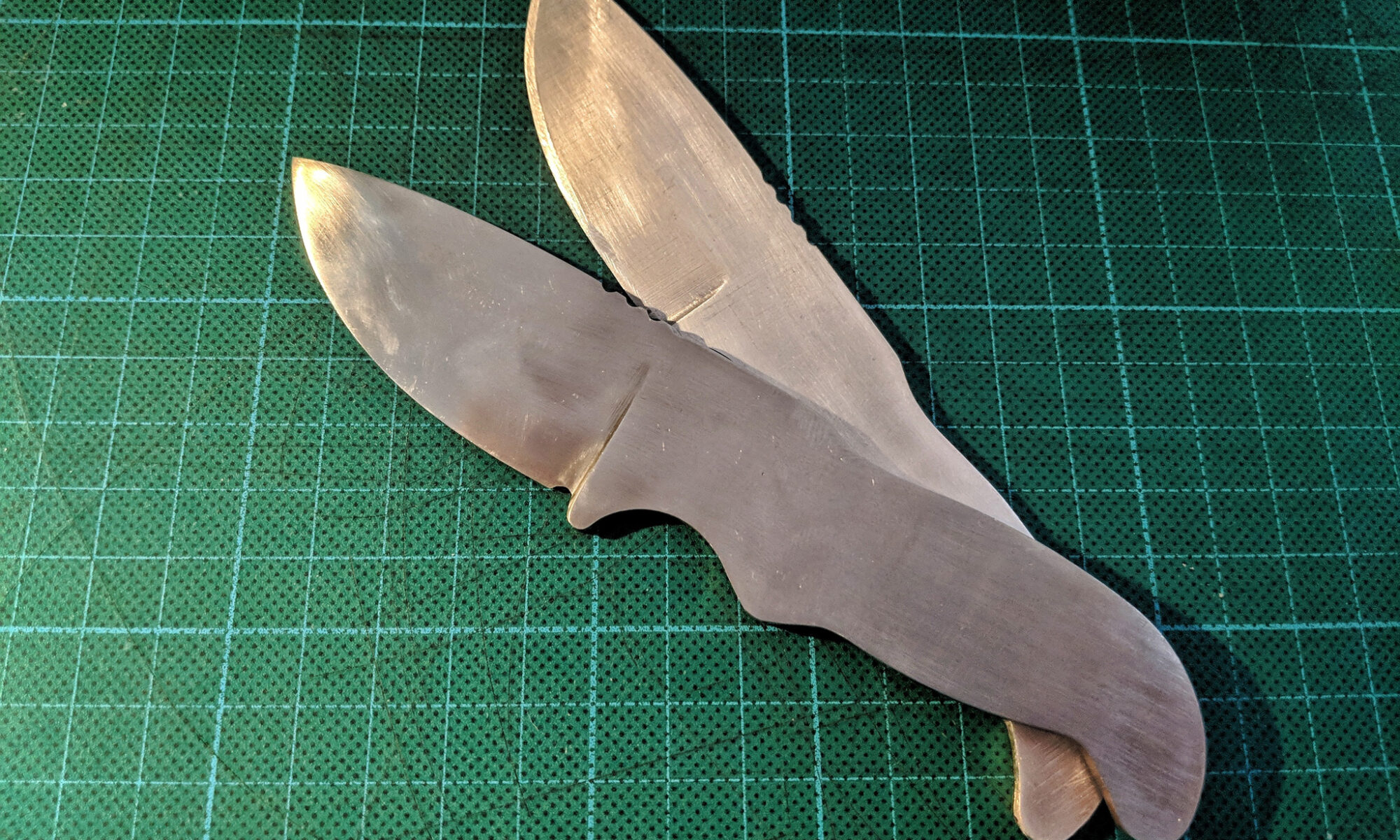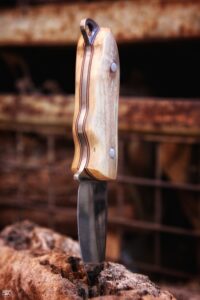When I built my first hidden tang knife, I needed a tool to sew out the slot, where the tang would fit into the wood. As I had nothing that worked, I built one myself.
I called it a hidden tang handle saw (HTHS) as a joke on Instagram.
Making a hidden tang knife
Until then I only had done full tang knives where two handle scales are glued to the sides of the blade. I had seen some videos of my favorite knifemakers how they make knives where the tang is not visible and the wood of the handle goes all around the steel that reaches inside the grip.
Continue reading “Making a hidden tang knife”How to treat your carbon steel knives
When I used my first self made kitchen knife for cooking I was a bit scared when I saw my knife afterwards. I had been cutting a lot of onions for the meal and the blade had lots of spots and stainmarks on it. I wasn’t even able to srub them off. I thought that I probably made something wrong with the knife like chosing a wrong steel or something.
Continue reading “How to treat your carbon steel knives”Markings, markings everywhere
I finished the design for my blade markings and etched all knives I had here. Like I posted before I wanted to have unique metal etchings on every blade.
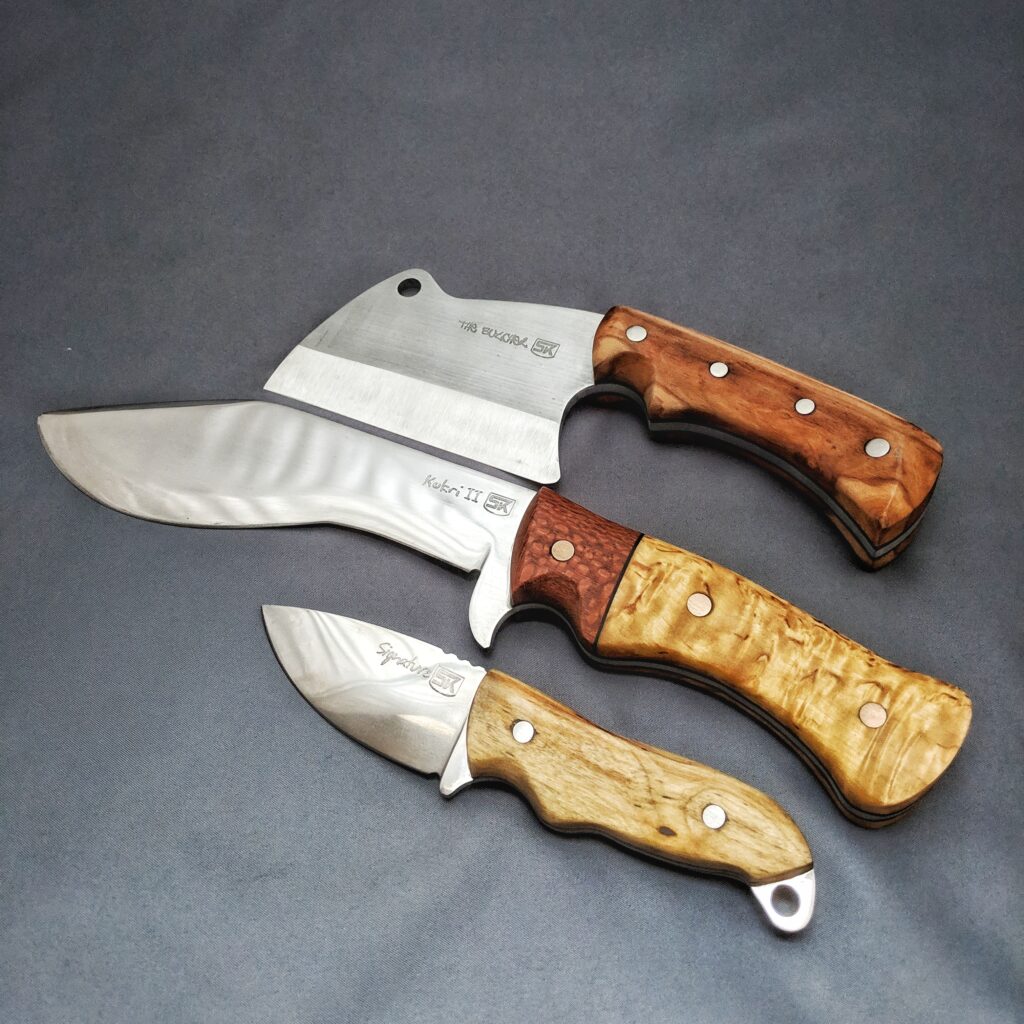
On one side of the blade I have my Simply-Knives SK-logo together with the name of the model. Every knife model I design has a unique name.
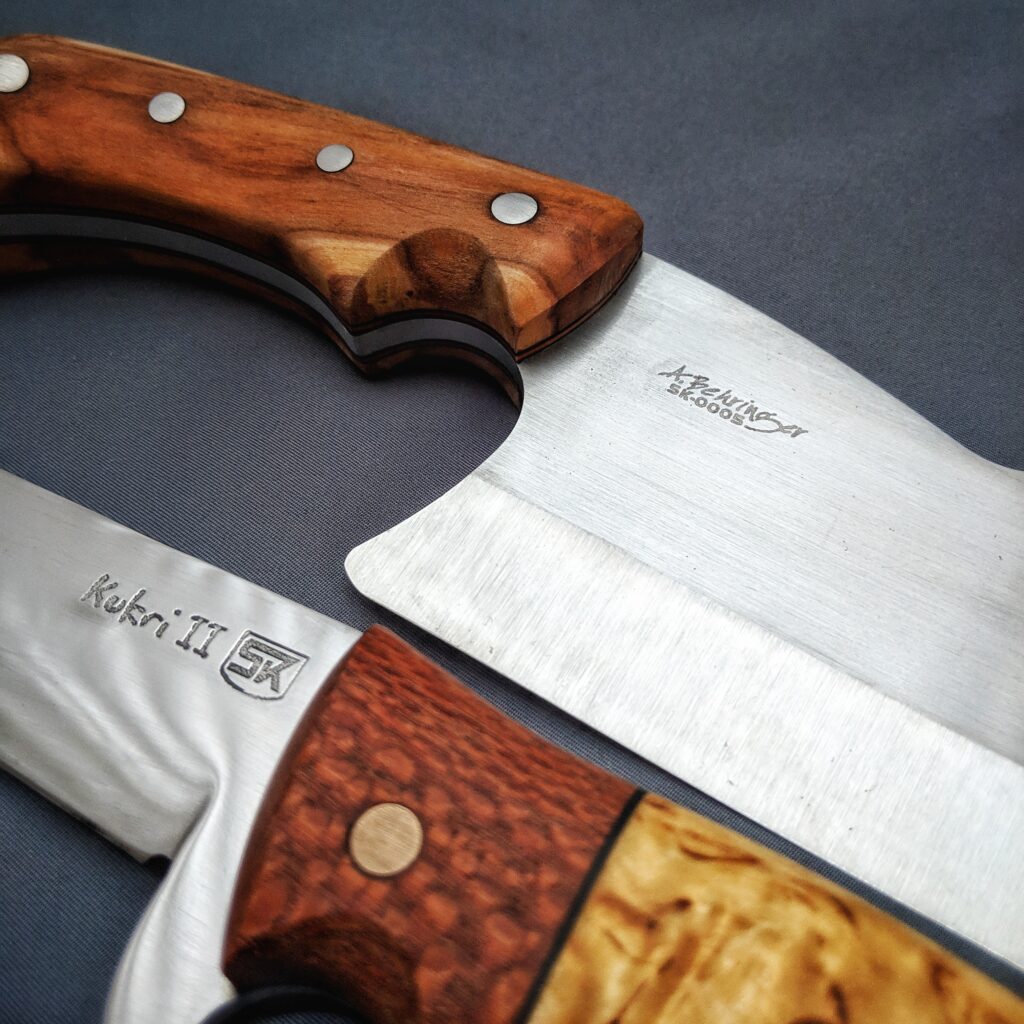
On the other side I add my name A.Behringer and a unique number of this knife. I will give every knife a number that identifies this single knife. I plan to put a certificate to every knife which matches the id metal etched on the blade.
The etching worked out pretty nice, despite the fact that the knives are ready made, the surface finish was done before and handles are allready on the blade. I was able to redo the surface finishes and clean up where the etching left some stains.
I am pretty happy with the results.
Conquering the Kitchen with a meat cleaver
I had some of the 4.5 mm 1.2235 (80 CrV2 or L2) steel of the bowie knife left. And as I had bought it as a 60 mm wide steel plate I wanted to make good use of the 200 mm piece left. I had seen a lot of meat cleavers from fellow knife makers and I had also thought about making something useful for the kitchen. I think there was more practical use for a kitchen knife, as the zomie apokalypse wasn’t near where my first knifes would be of good use. And many of our supermarket kitchen knifes are shitty anyways so I planned something on my computer.
The design phase went good. I wanted an handle which is a bit angled down and I liked the design of the handle of the outdoor knife I made for my father. Also I liked the idea of an arched spine that goes along the top of the whole knife. A hole in the top of the blade of a cleaver is mandatory I think.
Putting the paper stencil on the steel and cutting everything out with the angle grinder went nicely. What I did not like was the pattern the steel mill left on the plate and these marks where pretty hard to grind away. But finally I had my 240 grit scratch pattern on the steel.
The edge is completety straight and I anticipated the grinding of the bevels would be easy – I think I need a better grinder or at least some better belts – I already found Trizact belts for my machine so I will give them a try.
As this will be a heavy duty kitchen meat cleaver I wanted more durability of the design so I added another pin hole for the handle scales – just joking. I wanted to try something new and so I wanted 2 big and 2 smaller pins, just for the looks. Did I say I love my drilling machine?!
Next came the heat treatment. I already experimented in building a Venturi Burner but that did not work so well – that thing makes a lot of noise and the flame burns inside the tube – I think I will have to think of another design. Probably the tube is to big in diameter. But the forge gets hot with that thing too and I ended up with a proper hardened blade – file test was successfull. Then the blade went to the oven.
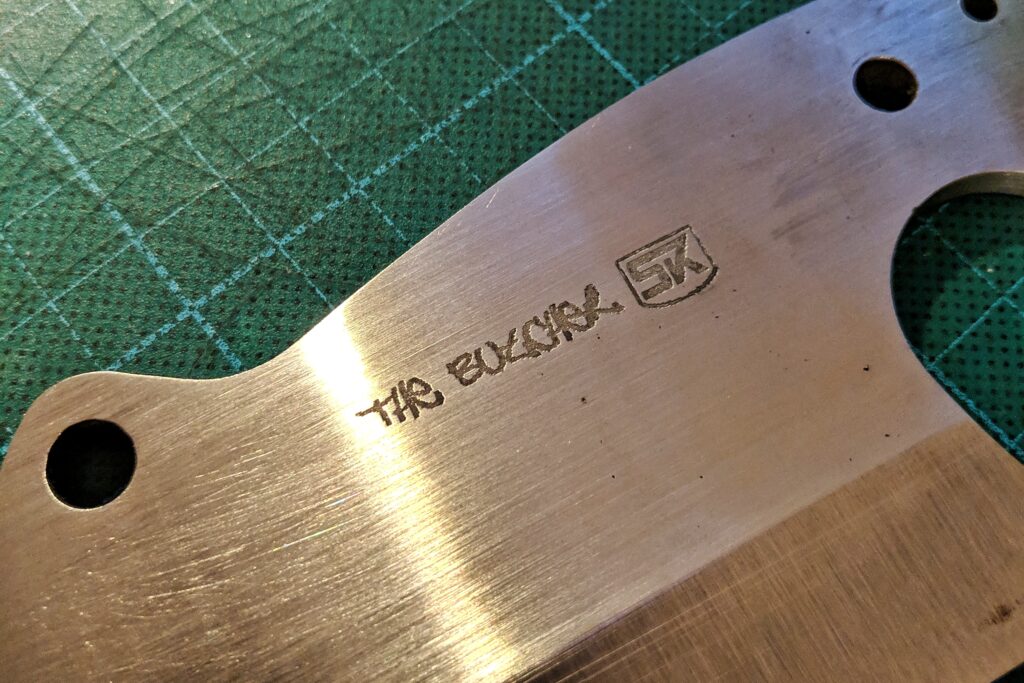
This is the first blade I tried etching my logo onto, and the name. I think “the utcher” fits nicely for a meat cleaver, even such a small one. Before I had removed the filthy remains of the heat treatment. And after the etching I refreshed the 240 grit scratch pattern. I also refreshed the bevel grinds as you can see in the pic I fckd up the scratch pattern there – I ended up with an extreme sharp scandi grind which goes straight to the edge with no secondary bevels.
Next came the handle. Last winter (2017/2018) our lovely small apple tree broke under the weight of the snow. The tree was just a bit over one meters high but it always had small delicious red apples. The whole family was sad to see it lying in the snow. I saved some of its bigger branches to build something from them – so why not as a knife handle where it could live forever for us?
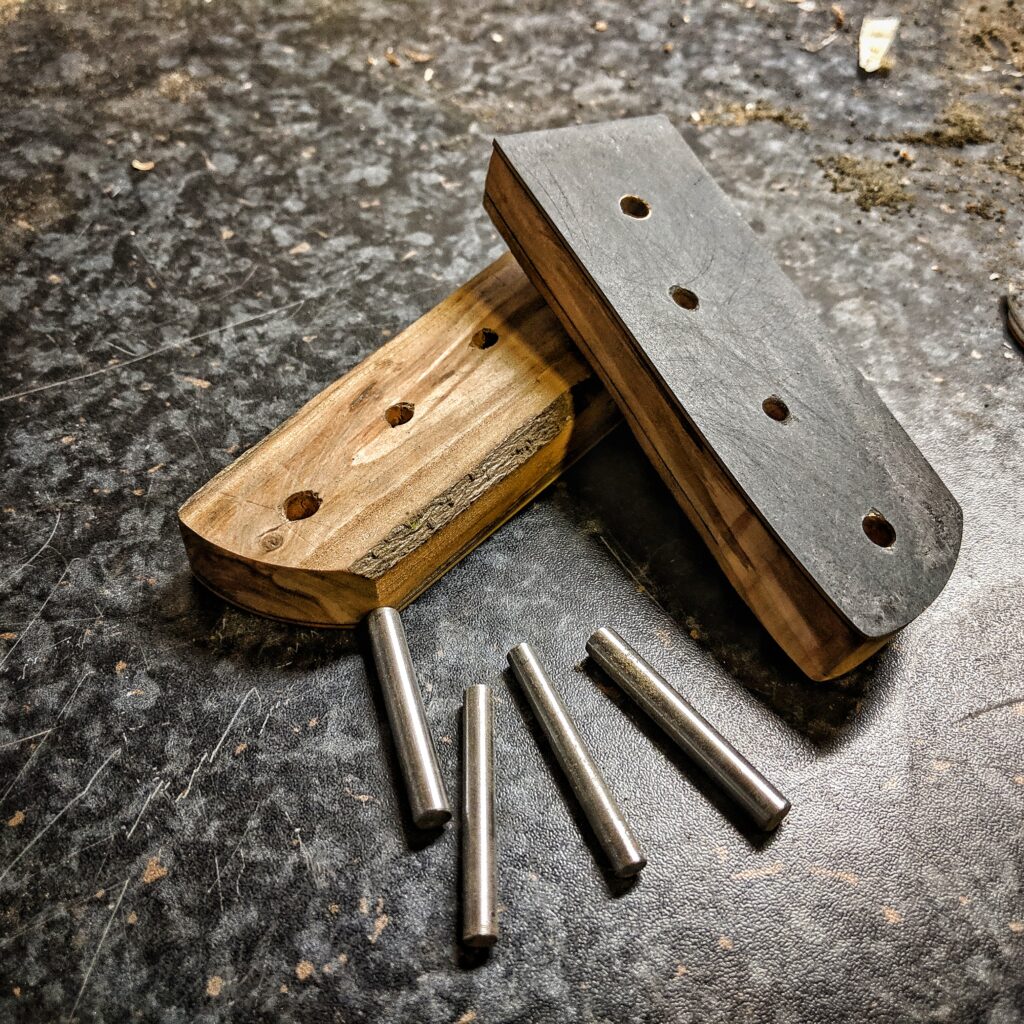
I cut a piece out of the apple wood branch, just big enough for the handle and chose orange and black for my liners. First I laminated the liners to the wood blocks and let it dry for a day. The next day I glued the blocks to the blade and had to wait another 12 hours before I could continue with the handle.
Grinding the handle scales to the tang and bringing everything into an ergonomic shape went pretty good. I am still mazed how beautiful the apple wood turned out when everything was at 240 grit and I treated the handle with linseed oil varnish.
And yes the knife IS sharp. While preparing the knife for some photos I cut myself pretty badly.
Fourth knife: A short blade hunting or bushcraft knife
Question: How do you call a knife with this design? It is intended as an universal hunting or bushcraft knife with a short blade. And like my last knife it is intended as a present for christmas 2018.
I had shown my last knife, that I made as a present for my brother, to my father. And man you should have seen his eyes. He loved it and said how much my brother will like it as a christmas present – so what could be better than making another knife for my father, too?
I had seen a short bladed knife design on Instagram that i liked and started designing a similar blade on the computer. This design was pretty hard to do. I wanted to have a short drop point knife with a swadge that grind line seamless blends into one line with the handle. And I wanted to have a curve upward behind the swadge where you could press the thumb against. I needed a lot more iterations than on my last designs before I had a layout I liked.
Finally I was able to transfer the finished form on the 1.2003 steel and cut it out with my angle grinder. I had built myself a file guide out of some scap metal and two M6 screws and tried out to grind the bevels with that attached to the blade. The result were not that good, not because of a crappy file guide but because my belt grinder was not grinding symmetrically on the plate behind the belt. So I ended up with one bevel line that was rounded and one was more rectangular. It took me a while to figure out how to fix this. I put some tape on one side of my flat file so I did not ruin the bevel itself and filed away the rounded part so I ended up with pretty symmetrical bevel lines.
Next came the swadge – man I failed on this one. It took some iterations to get them symmetrical and grind away some other mistakes I made. I don’t know what the problem was because on the previous knives that was one of the easiest tasks.
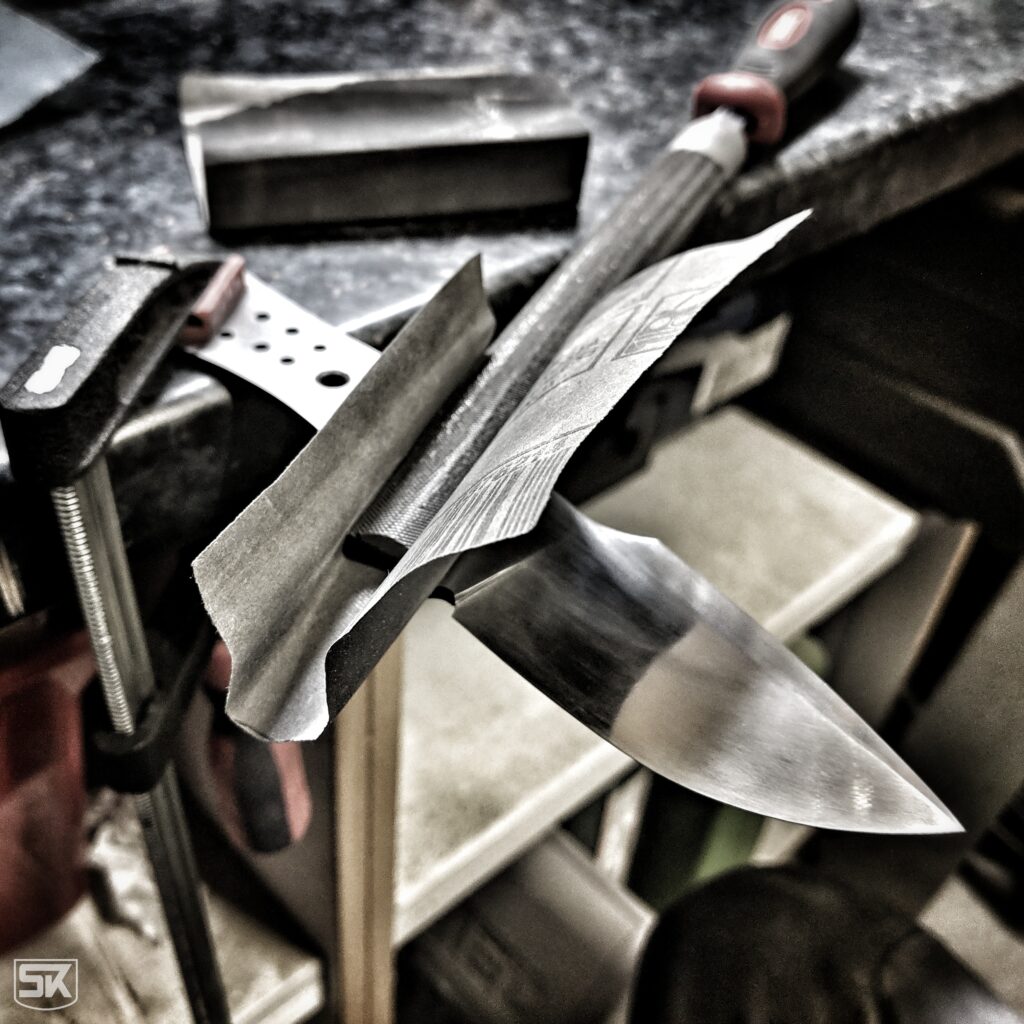
As I like to learn something new with every project I make, I wanted to add something new to this knife, too. Most of my knives so far have a handle with an extra shape for the index finger. This time I wanted to have a longer finger guard and a small silver line from the tang so that it forms kind of an open ring when seen from the side. For this, I had to grind the wood of the handle back down to the steel as I always did and then take the blade out and grind away a bit more of the wood. Then I had to smooth it out because after gluing the handles on the blade I would not be able to do so.
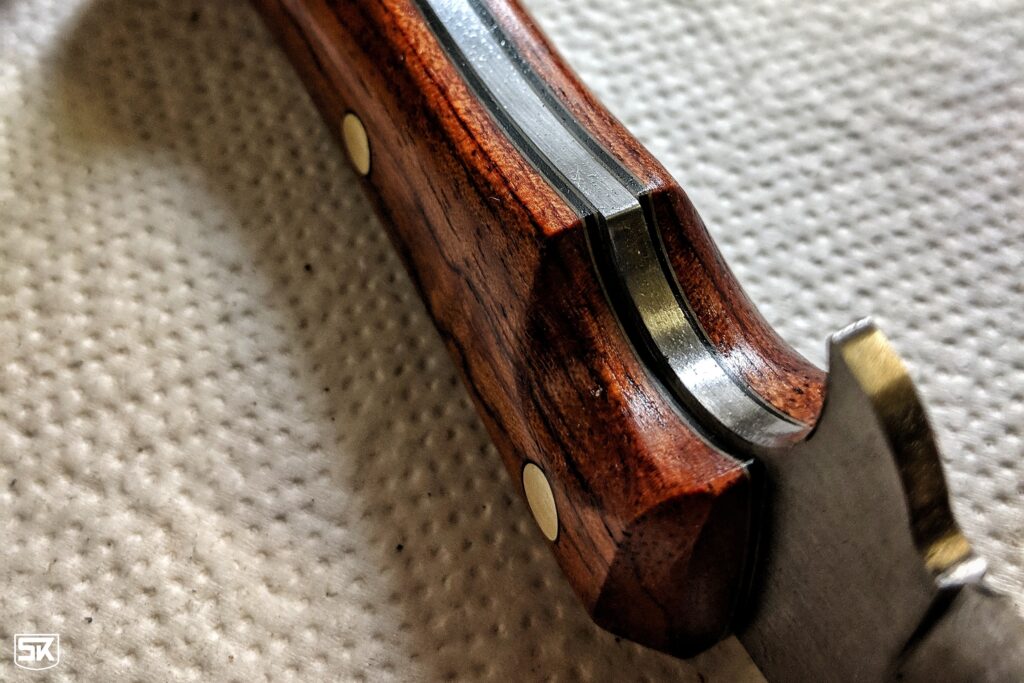
For the paper micarta liners I planned to use white and dark green – and yes I was going to laminate the liner myself, as always. The wood for the handles were bookmatched parts of Bubinga Curly. The wood turned out being pretty hard and grinding took a while. When I finally treated them with linseed oil I was surprised how dark the wood came out. But i liked it.
Next step was making a leather sheath.
Knife three: My first Bowie
I have a very close relationship with my brother – from childhood on we spent a lot of time together. He is one of, if not the most important person in my life. And when he saw the Kukri I made, he asked if I could make a knife for him some day.
We had November and there were still some weeks left so I decided to make a personal knife as a christmas present. He had told me he liked knives “like our father had” and that were Bowie knives. So I designed a nice recurved blade at my computer and again printed out several versions until I had a design that I liked.
I wanted to try a thicker steel and a different quality than the 3.2 mm 1.2003 steel I had used. So I got me some 1.2235 (80 CrV2) also known as L2 steel. The Steel has a thickness of 4.5 mm.
Transferring the form and cutting it out was straight forward. This time I wanted to do a flat grind again to avoid the sharpening problems I had on the konvex grind on the Kukri. And again I did it free hand which always is a big challenge to avoid facetting. But it turned out pretty good when I finally had a flat grind that I could feel while grinding.
The most difficult part was grinding a symmetrical swage and bevels on both sides so the point where the flat part of the blade ends is at exactly the same spot on both sides.
For the Handle I wanted to use the inverse parts I had left from making the handle of the Kukri – so for the front part I had Karelian Birch and the big part of the handle would be made of Leopard wood. Again I planned to make my own Micarta liners. This time I wanted to experiment with single layers of white sheets to create better separation of the colors. I chose black and a brighter red for the colors.
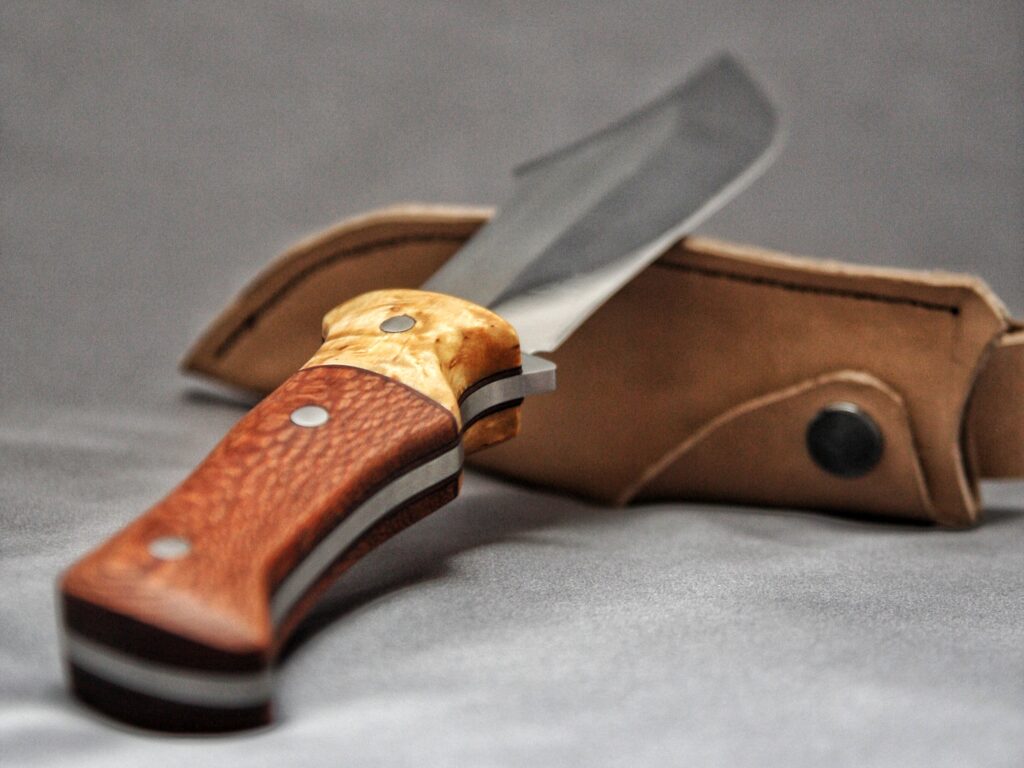
The lesson I learned on this knife was, that I wanted to get a better seamless surface and so I ground the wood of the handle and a bit of the steel between the handle halves. The result was a very wavy steel that was hard to sand back to a smooth curve again.
Another learning was to be extremely careful when mixing polished surfaces with scratch patterns. If you are not carefule enough you can start all over again.
How I make my own paper micarta liners
I bought some vulcanfiber liners and read a lot about how to make my own micarta grip blocks. And as I am always happy to try to build things myself instead of buying everything ready made I wanted to give it a try.
Continue reading “How I make my own paper micarta liners”My second knife, a Kukri/Khukuri
Before I even started to make the handle of my first knife, I began to make a bigger second knife. I am a big fan of a computer game series and I am playing an older title where Kukri or Khukuri Knifes play a big role in the game as one of the main weapons. So why not try and build one my own. I wanted to take a more compact and modern approach.
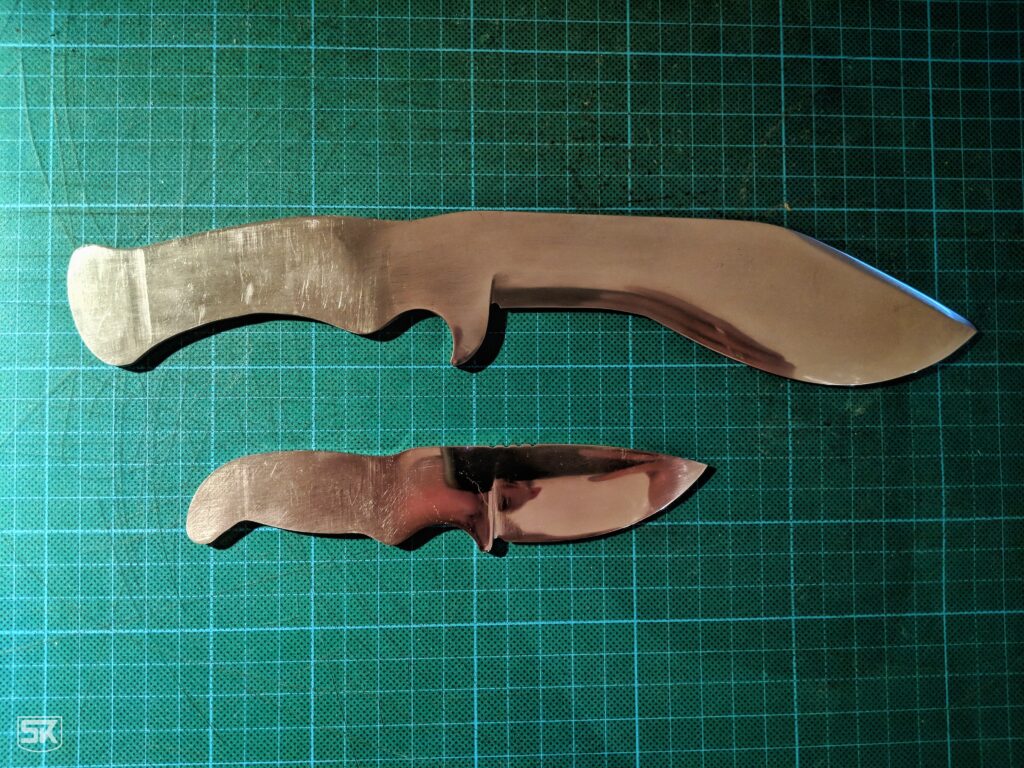
As I work a lot with computers and graphics it was clear I wanted to do the designs using a graphics program. First I thought about using dedicated CAD tools but I decided to go the easy way and chose Inkscape. I did some sketches and printed them out to get a feeling for the real dimensions of blade and handle and the details. It is easy to draw things but then I had to figure out how to do these things with steel. So I ended up doing some design iterations on paper.
I transferred the form onto my 1.2003 Steel and cut it out with my angle grinder. Everything went fine. I even was bold enough to try free hand grinding the bevels, yeah on my second knife with a strongly recurved edge… I did it on the slack part of my grinding belt and I was very happy with how much control I got instead of the flat part of the belt – the result were strongly convex grinded bevels. I hardened in my improvised forge out of porous concrete and a gas torch I fixed to the upper wall. The file did not bite into the steel so I am convinced the steel reached it desired hardness.
One thing I did before hardening was a very intense hand sanding and I put lots of effort into a nice surface finish. I did that again after the hardening and before tempering the steel. So I had to do it again after the steel came out nice and golden after one hour of its 200°C temperings in our kitchen oven. That is a lot of sanding and I am sure that is stupid to do. I keep that in mind for my next knife.
For the handle, I had something special in mind. I had bought some nice woods for the handle halves – Karelian birch and leopard wood. I planned to do a two-part handle and separate the woods with some self-made vulcan fibre and brass plates to get nice golden lines running around the grip.
I put the parts for the handle together with epoxy and let it dry over night. The results looked nice … but … unfortunately I saw that at the brass parts did not stick good enough and broke apart from the wood. So I ripped everything apart and did the handle without the brass. That worked out good after another night of waiting for the epoxy and so the next part was to put the halves on the blade.
I had used my battery powered drill to put the holes for the pins into the blade before the heat treat and I did the same to drill through the wood. And yes I am an idiot: the holes were not nice perpendicular to the blade. As I had not any wood left for the handle I put that learning aside and decided to finish the knife even with this flaws. Before I continued with the handle I sanded and polished the blade to a mirror finish.
I put everything together and let the epoxy dry over the night. So I was ready to grind the grip into shape the next day. That worked out very good and the result felt good in my hands. So next was hand sanding the grip up to 240 grit, watering the wood and hand sanding again after it dried. To protect the wood I now used three layers of boiled linseed oil.
And so close to finishing the knife I learned another big lesson: sharpening a strongly convex beveled blade is very hard to do if you want a nice sharp blade. I just could not get an angle flat enough without taking away some of the bevels. In the end, I was able to do the paper cutting test – but lesson learned.
My first knife
I liked the shape of my aluminium-grinder-test-dummy-knife so much, that I decided to do the exact same knife out of real steel. I had ordered some 1.2003 (C75) steel at a knife makers online shop together with some black and white vulcanfiber sheets and a diamond sharpening block.
The stuff arrived pretty quick and when I got home from work I immediately went to my workshop. I threw the aluminium dummy on the steel and transferred the form on the steel with a sharpie. Finally I could try out all the techniques I learned in the Videos, like cutting out the form with an angle grinder, shaping the edges with my belt grinder and finally grinding in the bevels.
As it was my first knife I did not even think about grinding the bevels free hand. So I built myself something out of a small block of wood where I ground one side to an angle where I could hold my knife to. And then I started grinding. For me the bevel grinding is the most difficult part.
The first results turned out pretty good – until I unintenionally took the wrong side of my bevel-grinding-wood-block and ground an ugly vertical line into the plunge. After fighting my self hate I took a sharpie and drew big black arrows on my wood block to save me from my idiotic self.
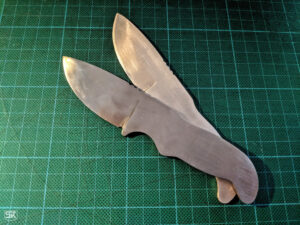
I managed to correct my mistake by grinding all over the side of the blade and finished the bevels with a nice flat angle. Next was drilling the holes with my cordless screwdriver and I soon learned, that I will need to buy some decent drill bits. Just to try it out I filed a grooved structure on the spine for the thumb. Lastly I polished the blade, just because i could.
As I had no wood for the handle I took some firewood I cut roughly into shape and cut in halves with a hand saw. For the pins I had bought some steel and brass rods and pipes of different diameter. I chose 5 mm steel pins.
I did not want to sacrifice the new vulcanfiber for the first knife so I decided to do my own. I built some motorcycle parts out of carbonfiber in the past and I have a good amount of epoxy left – also I have some experience in hand laminating – and I have colored cardboard from my kids – so not a big thing. I chose wine red and white cardboard (or more a thick paper around 130 g/m²) and laminated them together with the wooden grip plates.
My epoxy is pretty slow so I had a 12 hour brake…
The rest was simple. Cutting off the vulcanfiber to have it in line with the wood, drilling the holes through the would and getting the first finish to the plunge side of the grip and at the heel – I had decided to do an eye for a chain or something on the heel of the grip.
I glued everything to the blade with epoxy and again had another brake…
Last thing to do was getting the handle into shape – man I loved how my vulcanfiber turned out. To protect the wood I used an alcohol based varnish I had from oil painting – not a good idea. The next knives will be done with boiled linseed oil.
